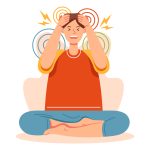
The Effectiveness of TMS on Treatment Resistant Depression
Written by: Saumya Sawant
Approximately 21 million adults in the United States suffer from depression each year, and this number is said to only rise in the upcoming years. Though treatments such as antidepressants and other medications work to address the symptoms of depression, they may not be effective for everyone, leading some to seek alternative treatments such as Electroconvulsive \Therapy (ECT) or Cognitive Behavior Therapy (CBT).
However, further complications can arise in individuals who suffer from Treatment Resistant Depression, which is defined as “…depression (which) still remain(s) symptomatic after adequate trials of antidepressant treatment as well as psychotherapy.” It is estimated that approximately 20% of those who are diagnosed with depression may also show signs of being treatment resistant, leading both researchers and physicians alike to find alternative ways to treat the disorder.
Recently, a novel type of treatment known as Transcranial Magnetic Stimulation (or TMS) has been found to help those with depression that is resistant to other forms of treatment or medication. TMS is a type of non-invasive therapy that utilizes magnetic fields to deliver a short electrical pulse to the brain. Besides being a relatively painless procedure with little to no side effects, it is also reported as being highly effective in treating the symptoms of Major Depressive Disorder. According to Future Psych Solutions, current success rates for TMS stand as high as 80%, and in some patients, even one round of treatment is enough to send them into full remission.
Understanding Treatment Resistant Depression
Major Depressive Disorder, or clinical depression, presents itself as a series of symptoms which include, but are not limited to:
- Low moods
- Changes in routine (i.e., eating less/more, sleeping less/more)
- Decrease in energy or functioning
- Loss of interest in things that may have once brought joy or enjoyment (ie, hobbies, sports, etc.)
- Suicidal thoughts or attempts at taking one’s own life
Though Major Depressive Disorder can be treated through certain medications and therapies, these may have little to no effect on Treatment Resistant Depression. This may be due to factors such as stress and genetics, making some individuals not only susceptible to depression, but also harder to treat as a result.
Symptoms of Treatment Resistant Depression may overlap with those of Major Depressive Disorder. However, there are a few additional key differences that may allow a healthcare professional to diagnose an individual with Treatment Resistant Depression:
- Symptoms of depression may last longer
- Symptoms of depression may be more severe
- Symptoms may include prolonged numbness or apathy
- At least two “First-Line” antidepressant medications don’t improve symptoms within 6-8 weeks
If an individual is diagnosed with Treatment Resistant Depression, a healthcare professional may suggest increasing the dosage of medication or seeking the services of a psychologist for talk therapy. They may also refer the patient to TMS treatment.
How TMS Works On Treatment Resistant Depression
The human brain is a fascinating organ. Weighing roughly 3 pounds and responsible for all major life functions within the body, the brain is run on a series of electrical impulses that can fire impulses as fast as 275 mph.
Individuals suffering from depression, however, often lose this ability to fire impulses due to lost connections between neurons. Neurotransmitters, which signal neurons to give or receive connections, may decrease in efficiency. In some cases, the receptors which pick up the neurotransmitters will fail to sense the neurotransmitter due to a lack of sensitivity, causing the signal to be weakened or stopped as a result.
TMS uses a magnetic field to deliver a short electrical pulse to the brain for the stimulation of neurons. In particular, TMS targets areas of the brain responsible for emotions, moods, or decision-making, such as the left dorsolateral prefrontal cortex. Studies done on patients with depression found this area to have decreased brain activity, accounting for the low mood symptoms often seen in those who are diagnosed.
TMS Success Rate
TMS boasts an incredibly high success rate, especially when compared to other forms of treatment such as SSRIs, whose effectiveness goes down dramatically when it fails to alleviate symptoms such as those seen in patients with treatment resistant depression. As mentioned earlier, TMS success rates can be as high as 80%, and often work immediately, with patients reporting immediate positive results after their first session. However, for the best results, it is recommended that TMS treatment lasts more than six weeks.
In one study analyzing the structural changes to the brain as a result of TMS, gray volume matter increased post-TMS treatment as compared to pre-TMS treatment, with participants of the study also showing less severe depression symptoms at the conclusion of the experiment. Since a decrease in gray matter within the brain is also associated with memory loss, inability to effectively reason or make decisions, among other things, the findings of this study seem to indicate that TMS treated more than just the mood aspect of depression in patients who had received the treatment.
Is TMS Right For You?
If you, or another individual you know, is suffering from treatment resistant depression, consult your doctor to see if TMS is right for you.



